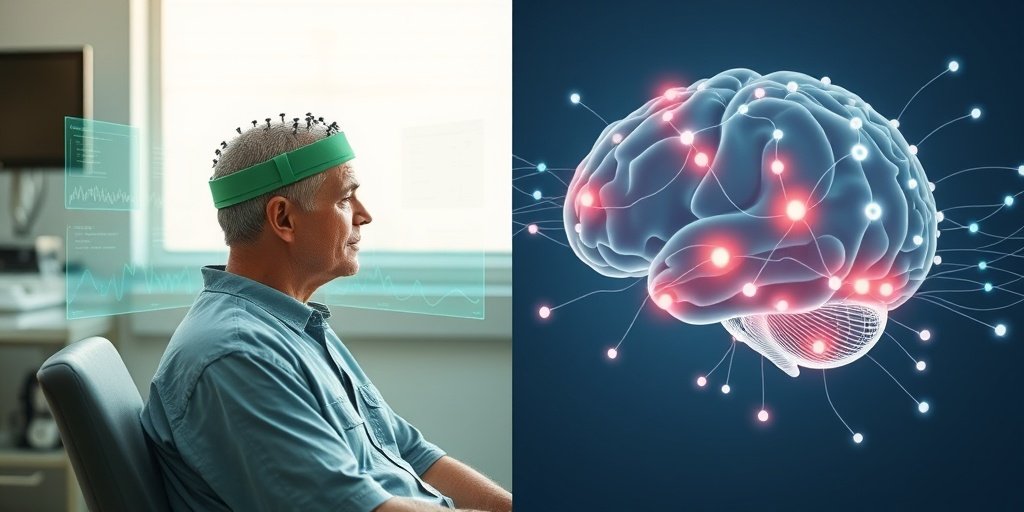⚡ Quick Summary
This study investigates the use of hybrid deep learning models to enhance the classification of electroencephalogram (EEG) signals in brain-computer interfaces (BCIs), achieving an impressive accuracy of 96.06% with the proposed model. The findings highlight the potential of these advanced techniques to significantly improve BCI performance in motor imagery tasks. 🧠
🔍 Key Details
- 📊 Dataset: PhysioNet EEG Motor Movement/Imagery Dataset
- 🧩 Features used: EEG data from various motor tasks
- ⚙️ Technology: Hybrid model combining CNN and LSTM
- 🏆 Performance: Hybrid model: 96.06% accuracy; Random Forest: 91%
🔑 Key Takeaways
- 🧠 Brain-computer interfaces (BCIs) enable communication between the brain and external devices.
- 💡 Accurate classification of EEG signals is crucial for effective BCI systems.
- 🏆 Random Forest was the best-performing traditional classifier with an accuracy of 91%.
- 🤖 Deep learning techniques like CNN and LSTM showed accuracies of 88.18% and 16.13%, respectively.
- 🌟 The hybrid model outperformed all other methods, achieving 96.06% accuracy.
- 🔍 This research emphasizes the importance of combining different machine learning approaches for better results.
- 🌍 Potential applications include advancements in assistive technologies and rehabilitation.

📚 Background
Brain-computer interfaces (BCIs) represent a groundbreaking technology that allows individuals to control external devices using their brain activity. The accurate classification of EEG signals is essential for the success of BCIs, particularly in applications involving Motor Imagery (MI), where users imagine movements rather than physically performing them. As the demand for effective BCI systems grows, so does the need for improved classification techniques.
🗒️ Study
This study aimed to enhance the classification of EEG signals in BCIs by evaluating various machine learning classifiers, including K-Nearest Neighbors (KNN), Support Vector Classifier (SVC), Logistic Regression (LR), Random Forest (RF), and Naive Bayes (NB). The researchers utilized the PhysioNet EEG Motor Movement/Imagery Dataset, which contains EEG data from both actual and imagined motor tasks, to assess the performance of these classifiers.
📈 Results
Among the traditional classifiers, the Random Forest model achieved the highest accuracy of 91%. In contrast, the deep learning approaches, specifically Convolutional Neural Networks (CNN) and Long Short-Term Memory (LSTM)88.18% and 16.13%, respectively. However, the proposed hybrid model, which integrates CNN and LSTM, significantly outperformed all other methods, achieving an exceptional accuracy of 96.06%.
🌍 Impact and Implications
The findings from this study have profound implications for the future of brain-computer interfaces. By demonstrating the effectiveness of hybrid deep learning models, this research paves the way for more robust and precise BCI systems. Such advancements could lead to improved assistive technologies for individuals with disabilities, enhancing their quality of life and independence. The potential applications extend beyond healthcare, influencing fields such as gaming, virtual reality, and neurofeedback.
🔮 Conclusion
This study highlights the remarkable potential of hybrid deep learning models in enhancing EEG signal classification for brain-computer interfaces. With an accuracy of 96.06%, the proposed model represents a significant leap forward in BCI technology. As research in this area continues to evolve, we can anticipate exciting developments that will further integrate AI and machine learning into our daily lives, particularly in assistive technologies. 🌟
💬 Your comments
What are your thoughts on the advancements in brain-computer interfaces and the role of hybrid deep learning models? We would love to hear your insights! 💬 Leave your comments below or connect with us on social media:
Enhanced EEG signal classification in brain computer interfaces using hybrid deep learning models.
Abstract
Brain-computer interfaces (BCIs) establish a communication pathway between the human brain and external devices by decoding neural signals. This study focuses on enhancing the classification of Motor Imagery (MI) within BCI systems by leveraging advanced machine learning and deep learning techniques. The accurate classification of electroencephalogram (EEG) data is crucial for enhancing BCI performance. The BCI architecture processes electroencephalography signals through three critical stages: data pre-processing, feature extraction, and classification. The research evaluates the performance of five traditional machine learning classifiers- K-Nearest Neighbors (KNN), Support Vector Classifier (SVC), Logistic Regression (LR), Random Forest (RF), and Naive Bayes (NB)-using the “PhysioNet EEG Motor Movement/Imagery Dataset”. This dataset encompasses EEG data from various motor tasks, including both actual and imagined movements. Among the traditional classifiers, Random Forest achieved the highest accuracy of 91%, underscoring its efficacy in motor imagery classification within BCI systems. In addition to conventional approaches, the study also explores deep learning techniques, with Convolutional Neural Networks (CNN) and Long Short-Term Memory (LSTM) networks yielding accuracies of 88.18% and 16.13%, respectively. However, the proposed hybrid model, which synergistically combines CNN and LSTM, significantly surpasses both traditional machine learning and individual deep learning methods, achieving an exceptional accuracy of 96.06%. This substantial improvement highlights the potential of hybrid deep learning models to advance the state of the art in BCI systems, offering a more robust and precise approach to motor imagery classification.
Author: [‘Das A’, ‘Singh S’, ‘Kim J’, ‘Ahanger TA’, ‘Pise AA’]
Journal: Sci Rep
Citation: Das A, et al. Enhanced EEG signal classification in brain computer interfaces using hybrid deep learning models. Enhanced EEG signal classification in brain computer interfaces using hybrid deep learning models. 2025; 15:27161. doi: 10.1038/s41598-025-07427-2